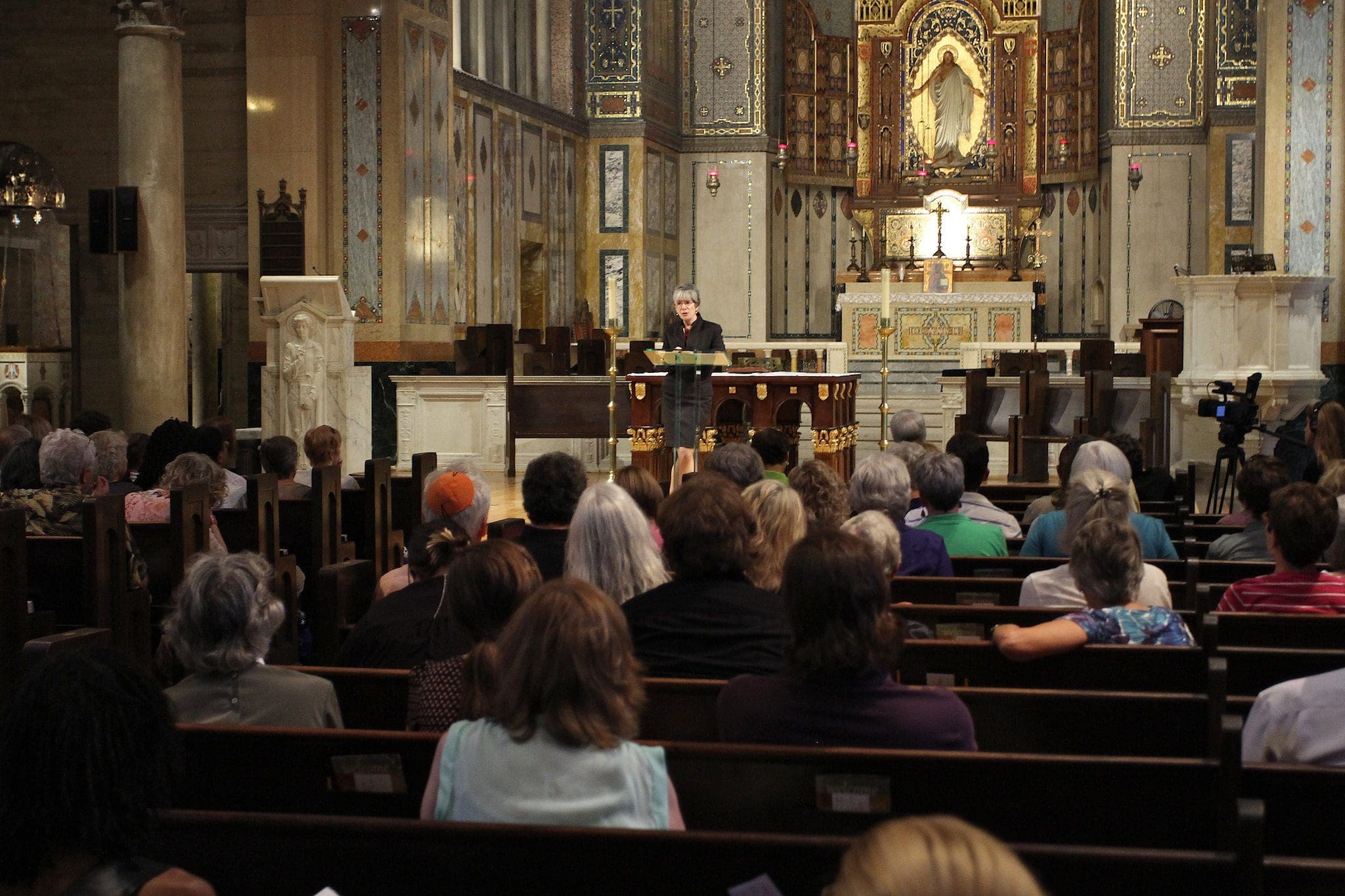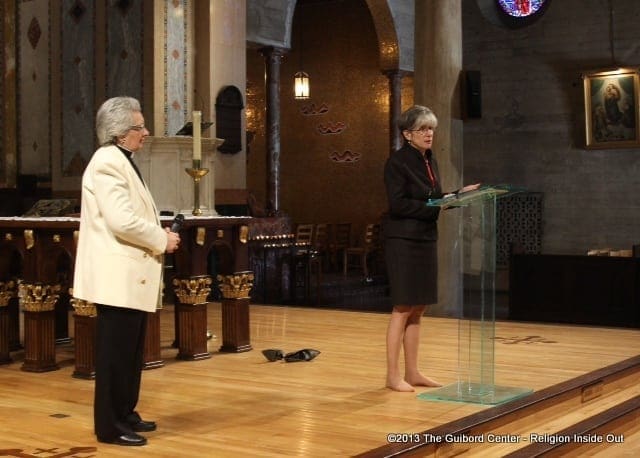


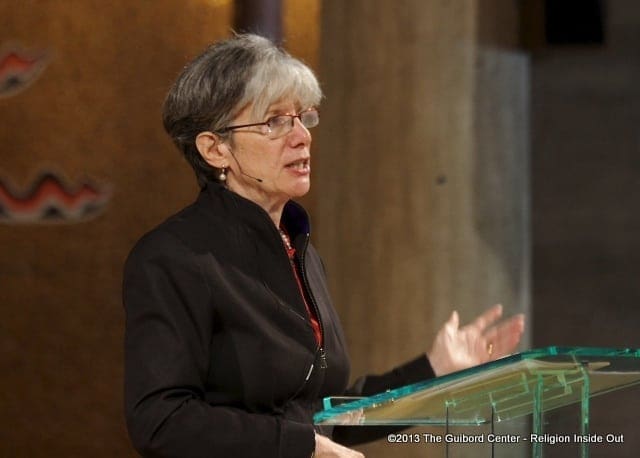
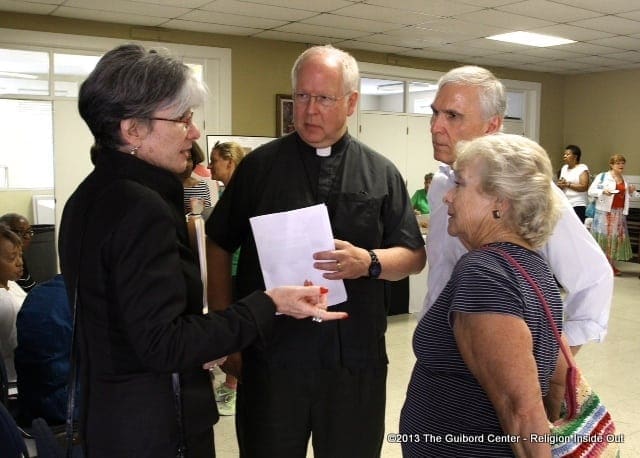
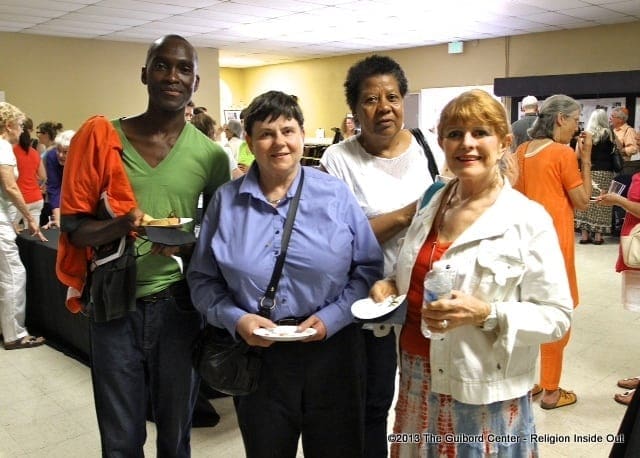
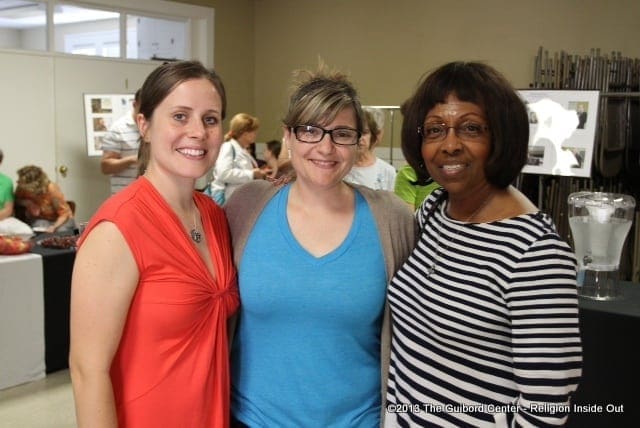

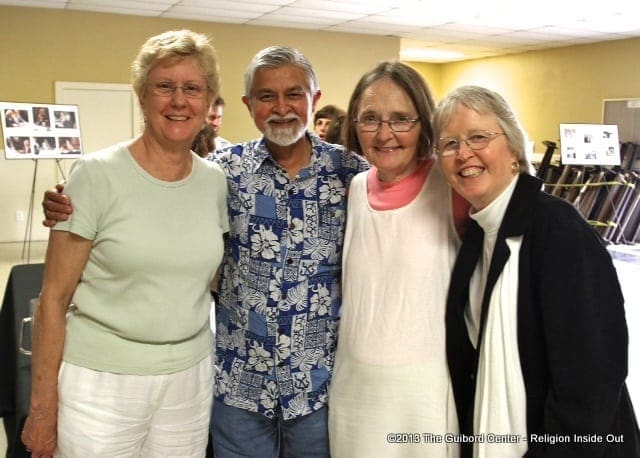

Dr. Amy-Jill Levine leaned on the altar, kicked off her heels and took off into a topic she was eager to tackle: The Bible, Women and Violence.
“ANY TIME the Bible gives rise to something that’s violent – that’s a misuse of the text!… To hold the Bible in one hand and to engage in violence with the other is both a sin and an obscenity. That should be pretty clear.”
There was no doubting where Amy-Jill stood in any of this as she reeled off the facts and figures of domestic violence in the United States and then in the world. She moved seamlessly from there into the role that well-meaning rabbis and priests and pastors play in perpetuating violence against women when they fail to address victims’ spiritual concerns embedded in the pages of their holy scriptures. “Many rabbis and pastors and priests fail to use the biblical text as a basis to speak out about and against domestic abuse, rape and incest.”
Feminists fared no better as “A.J.” quickly pointed out the absurd futility of telling religious women to dismiss the Bible, to simply ignore passages. “It doesn’t help,” she chided and suddenly the assemblage stood witness to the agonizing reality A.J. brought before them of deeply faithful women trapped by love of husband and church and children, struggling to create a place of safety for themselves and their children within a world of violence, a place to live that honored their religious truth, their economic reality and their integrity.
She then leapt right into Genesis, Chapter 3, one of a number of religious texts used to keep women in situations of abuse, first tackling what doesn’t help and then, thankfully, moving into the things that might. [She used the King James Version because men and women in these situations most often refer to it.]
She offered the reading from Galatians 3, Verse 28, and re-contextualized the readings. What did they mean to the people who heard them when they were first spoken? What was the world they referred to like? She ended that piece for the moment with the final note that “Rule does not mean abuse.”
A.J. moved to Ephesians, Chapter 5, another troubling and misunderstood text often cited by women struggling in the midst of marital violence, and I Peter Chapter 3, another dangerously misconstrued text, that puts women in a place of subservience and oppression. It became easy to see why these passages are ignored. The phrasing difficult. The language is convoluted. The need for good translation is an imperative as is an appreciation of the context into which they were sent. We were treated to an example of the importance of translation to a glimpse of a curious young Jewish girl puzzled at a painting of Jesus surrounded by children entitled “Suffer the Little Children to Come Unto Me”. Thankfully she went to a kind and knowledgeable mother who explained that “suffer” doesn’t always mean “to bear pain” sometimes it means “to permit”. But as A.J. pointed out, “some people still read ‘suffer the children, as the kids have to suffer’”… not at all what Jesus said or meant.
Before looking at the contexts of these readings, A.J., ever balanced, articulated the important reality ignored by many that “some women find voluntary submission to be emotionally and spiritually satisfying.” She cautioned however, that “choosing to obey is not the same thing as choosing to be battered.”
The more helpful readings of Ephesians and I Peter places them as part of the larger genre of “The Household Codes” that were a part of the fabric of the Roman Empire and that governed all kinds of behaviors. Understanding the reasons for the codes puts individual passages in an entirely different light than we bring to them today. As A.J. explained and filled in contexts, the readings took on a much different meaning.
As for the letters written to specific church communities that comprise much of the New Testament: A.J. reminded us that “They were written to ‘The Church at Ephesus’. It doesn’t say ‘To the People of Los Angeles.’ We’re reading somebody else’s mail!” The audience laughed and suddenly grasped the preposterousness of thinking that we can understand someone else’s mail. The tragic absurdity became agonizingly clear as passage after passage was placed carefully back into the context that gave rise to it.
Suddenly we were able to see a young church placed in grave danger by unruly Christian wives married to pagan husbands living under the absolute rule of the oppressive and ever-present Roman Empire where God and governance were one. That world required a level of careful vigilance unthinkable for Twenty-First Century Christian Californians, or Americans or most Westerners. There are, of course, many places in the world today where Christians are living in such danger. Respect for local customs and sensibilities is as much a matter of life and death for such modern Christians in those regions today as it was for the early communities of Ephesus, and Corinth, and Rome.
Appreciating historical context took on a level of urgency as A.J. shared a story about how a woman came to her seeking advice on turning in a child predator to the legal authorities. The church elders had told her not to do so in the light of I Corinthians 6 where St. Paul instructed the early community not to go to the local authorities. A.J. pointed out that in Paul’s time the local courts were all run by pagans. Today’s courts all require swearing on a Bible. The original context no longer holds true. And Jesus’ concern for the well-being of children is absolutely clear. It trumps allowing a predator to free access to hurting them. There was an uncomfortable realization dawning on the audience at the enormity of the ignorance that keeps women and girls and children and their families and their fathers and their brothers and their husbands and their sons and even the perpetrators and their families alone in the dark in danger.
As hard as this material is, we must face it and A.J. was helping us to do just that – one passage at a time.
And then she suddenly shone a light on the other half of the Household Codes and we were all left blinking in wonder that we have never considered that there was another half. “Along with exhortations to wives, the Bible also gives us exhortations to husbands!” These codes govern not only how wives are to behave, but how husbands are to behave as well. Hmmm.
I Corinthians Chapter 7 “…the husband render unto the wife due benevolence and likewise also the wife unto the husband.” And in Ephesians: “Husbands, love your wife just as Christ loved the Church and gave himself up for her.”
“Nowhere does the text [Bible] tell husbands that they should or even may engage in violence against their wives.” That was a relief. The audience could breathe – but only for a moment…
Our mentor continued: “So how come this message gets conveyed? [because in part] A number of people who have not read the Bible closely come up with the idea that the Bible permits violence against women [and] some people believe that the Bible condones violence against women because it depicts God as a violent husband.”
After making it clear that the Bible does not condone violence, A.J. led those gathered into a descent of darkness as we turned again and again to passages from the Old Testament to the Book of Revelations that do, in fact, describe violence explicitly.
There they are in plain sight – stories of brutality and horror, of rape and incest and murder, of calculated cruelty and unspeakable, unjustifiable abuse against even the great King David’s daughter and many other utterly innocent women. The Bible is filled with violence against women and girls. Why? What does it mean? Are we simply to accept that this is how the world is? Now we were about to confront the Bible with an agonizing openness and the bright, clear scholar who has dedicated her life to meeting this sacred text with integrity and rigor was about to lead us through many of such passages showing us the dangers of mis-reading.
We began with the most troubling, with God shown as the perpetrator of violence against women. Whether it is the prophet, Josiah, or Ezekiel or John in The Book of Revelations, these prophets all refer to the unfaithful people as an unfaithful wife and God as a violent husband who brutalizes her.
A.J. carefully showed that we misread the texts and miss the point entirely when we read these as justification or even as endorsements for such violence.
Three critical points
1.) God being depicted as a male and as a husband does NOT mean that men are God or 2.) that husbands are entitled to treat their wives in such a way. (God alone is God.) and most importantly, 3.) the prophets used such imagery to horrify their listeners – to shake them so deeply that they would immediately stop their evil ways and turn back to God and thereby allow God to resume God’s natural beneficence.
The Bible is filled with many stories of violence because it was part of the culture and part of the time as it is today but rather than endorsing the violence, or ignoring it, these stories confront the violence and condemn it. The story of Lot offering his daughters to the mob at Sodom in Genesis, and of the Levite doing the same with his concubine in Judges 19, the rape of Dinah in Genesis 34 and its bloody aftermath and others – these are tragedies pure and simple, great gaping senseless horrors that destroy everyone involved.
“They do not teach that women are property, rather they show the dangers of such a view.” The brutalizing of women is not a norm but a signal that a society is descending into ruin. These stories come to us as a somber warning that we need to pay attention to the cowardice and the selfishness and the callous sense of entitlement that destroy people and families and nations.
“The worst thing the authors of the Bible could think about in terms of social disintegration [was] the rape and murder of women. The Bible recognizes that. Perhaps it’s about time our society did as well.”
These stories in the Bible are intended to leave us asking the right questions, the tough questions about justice and mercy and entitlement and anger… about the roots of violence and the families in all parts of the story, about the multigenerational damage that needs to be addressed in systems, and… about forgiveness. A.J. surprised many in the audience by including her own warning about the potential cruelty and abusiveness of blindly seeking forgiveness in place of wrestling with the larger issues that have no easy answers but engage us in the right concerns.
She concluded by saying:
Nothing about this subject is easy.
The Bible forces us to confront domestic violence over and over again. It shows us that to respond to violence with more violence is not a solution.
It insists on care for the victim even as it insists that we also care for the perpetrator. It shows that violence impacts not just the victim and the perpetrator but the family, the state, the nation.
It teaches a marital bond of mutual submission which puts greater demands on the husband than the wife.
It asks that we determine what teachings are time-bound and what teachings are good for all time.
It demands that we continue to interpret the text with a focus on love of God and love of neighbor.
And it makes clear that we are our brother’s and our sister’s keepers – that to care for victims and perpetrators both is our responsibility.
The Bible helps us ask the right questions.
What do we do to prevent abuse?
What do we do to heal the victim?
What doe we do to prevent recidivism?
What do we do to provide comfort for the families of the victims and perpetrators both?
What is the role of the religious person?
At that point we moved into questions and answers. As you will see the final question gave rise to the ten-point statement that follows. Please experience Dr. Amy Jill Levine for yourself by watching the video.

